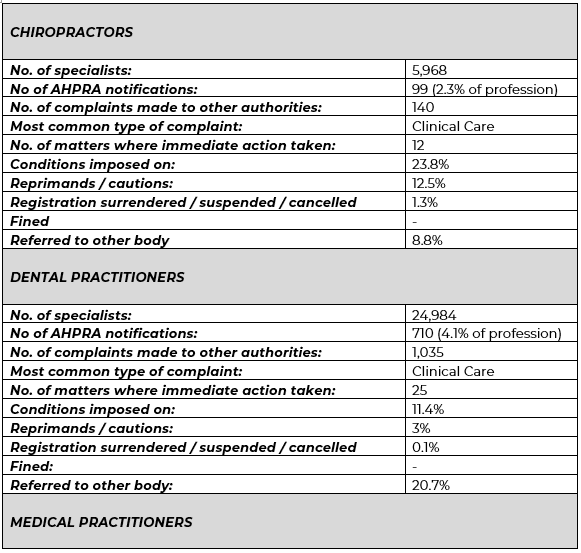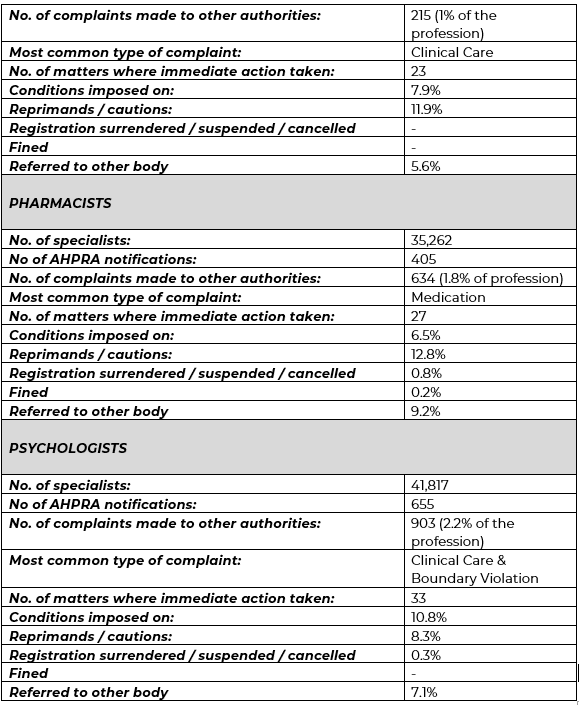OVERVIEW:
- Each year AHPRA reports on a number of complaints against practitioners and their outcomes.
- Complaints can result in a number of outcomes, such as restriction, suspension, fines and cancelled registration.
- Medical practitioners, dental practitioners, chiropractors, and psychologists had the highest rate of complaints.
- The majority of complaints relate to clinical care and boundary violations.
THE AHPRA ANNUAL REPORT
Each year, AHPRA releases a report addressing the number of complaints and actions taken against a range of practitioners subject to AHPRA Registration.
These reports include a review of a number of practitioners, including:
(a) Aboriginal & Torres Strait Islander Health Practitioners;
(b) Chinese Medicine practitioners;
(c) Chiropractors;
(d) Dental practitioners;
(e) Medical radiation practitioners (Sonographers, radiographers etc.);
(f) Medical practitioners;
(g) Nurses & Midwives;
(h) Occupational therapists;
(i) Optometrists;
(j) Osteopaths;
(k) Paramedics;
(l) Pharmacists;
(m) Physiotherapists
(n) Podiatrist; and,
(o) Psychologists.
A full copy of the current report and reports from previous years can be downloaded here.
Within each specialty, the AHPRA Report provides details of:
- The number of specialists practising within that speciality;
- The number of notifications lodged with AHPRA;
- The number of complaints made to other complaint bodies such as speciality specific boards (dental board, chiropractic board, midwifery association etc.) and other regulatory bodies such as the OHO and HCCC
- The most common type of complaint:
- Clinical care;
- Boundary violation;
- Communication;
- Health impairment;
- Documentation (record keeping) etc.
- The number of matters where immediate action is taken to ensure the safety of patients;
- The number of matters where conditions have been imposed on practice;
- The number of matters where practitioners have been reprimanded or cautioned;
- The number of matters where practitioners have had their registration surrendered, suspended, or cancelled;
- The number of fines; and,
- The number of referrals to other bodies such as specialty boards and bodies.
SUMMARY OF COMPLAINTS BY SPECIALTY
As expected, every medical speciality experiences formal complaints for a number of different reasons.
Upon review of the AHPRA report, we have summarised the most significant reporting of complaints during the 2020/2021 annual year:
WHAT DOES THIS MEAN?
By far, the professions with the most complaints are:
(1) Medical practitioners: with 5.7% of the profession having complaints made against them
(2) Dental practitioners: with 4.1% of the profession having complaints made against them
(3) Chiropractors: with 2.3% of the profession having complaints made against them
(4) Psychologists: with 2.2% of the profession having complaints made against them
This means that these professions are subject to the most complaints due to clinical care, that being the treatment they provide falls below the expected standard of care, and boundary violations, that being transgressions of the practitioner-patient relationship.
COMPLAINTS & AHPRA INVESTIGATIONS AND IMPACT ON MEDICAL NEGLIGENCE
By far, the majority of medical negligence claims are made in relation to clinical care and boundary violations.
Clinical Care
Clinical care refers to the treatment and care provided to a patient by a medical professional or ancillary health care provider. When mistakes are made or care is not provided to the required standard, injury, loss, and damage can occur.
For more on the level of care expected of professionals, see our article titled "4 tips to be successful in your medical negligence claim".
Boundary violations
Boundary violations occur when a practitioner acts outside the practitioner-patient relationship. These violations are often ethical violations that have significant legal consequences for practitioners.
An example of a boundary violation is forming a sexual/intimate relationship with a current or former patient.
Further information on boundary violations can be accessed here: "Do you know the boundaries of a doctor patient relationship".
Both breaches of duty and care and boundary violations are compensable in law if a patient/former patient has suffered injury, loss, and damage, and can establish breach and causation - the requirements of medical negligence.
To find out more on medical negligence damages, see our recent article "4 most common damages in medical negligence claims."
One download between you and your key to compensation...
Want to fast track the process with our free interactive workbook?
Medical Law © 2020 Privacy & Disclaimer







